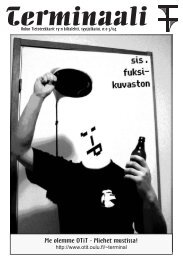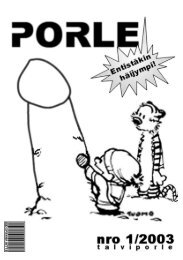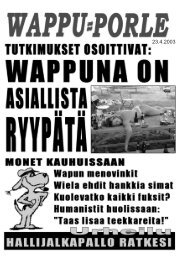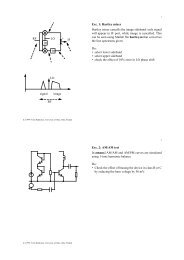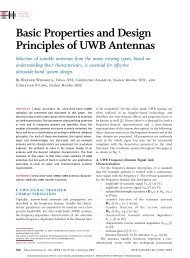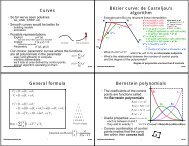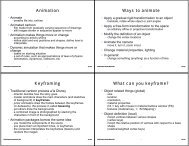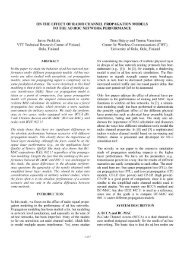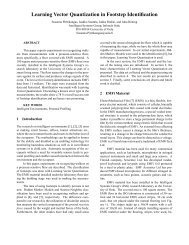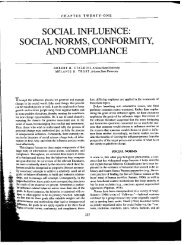Accurate, Dense, and Robust Multiview Stereopsis - Department of ...
Accurate, Dense, and Robust Multiview Stereopsis - Department of ...
Accurate, Dense, and Robust Multiview Stereopsis - Department of ...
Create successful ePaper yourself
Turn your PDF publications into a flip-book with our unique Google optimized e-Paper software.
1364 IEEE TRANSACTIONS ON PATTERN ANALYSIS AND MACHINE INTELLIGENCE, VOL. 32, NO. 8, AUGUST 2010<br />
Fig. 2. (a) A patch p is a (3D) rectangle with its center <strong>and</strong> normal<br />
denoted as cðpÞ <strong>and</strong> nðpÞ, respectively. (b) The photometric discrepancy<br />
fðp; I1;I2Þ <strong>of</strong> a patch is given by one minus the normalized cross<br />
correlation score between sets qðp; IiÞ <strong>of</strong> sampled pixel colors. See text<br />
for details.<br />
image RðpÞ 2V ðpÞ). The photometric discrepancy function<br />
gðpÞ for p is defined as<br />
1 X<br />
gðpÞ ¼<br />
hðp; I; RðpÞÞ; ð1Þ<br />
jV ðpÞnRðpÞj<br />
I2V ðpÞnRðpÞ<br />
where hðp; I1;I2Þ is, in turn, defined to be a pairwise<br />
photometric discrepancy function between images I1 <strong>and</strong><br />
I2. More concretely (see Fig. 2), given a pair <strong>of</strong> visible images<br />
I1 <strong>and</strong> I2, hðp; I1;I2Þ is computed by 1) overlaying a<br />
grid on p; 2) sampling pixel colors qðp; IiÞ through bilinear<br />
interpolation at image projections <strong>of</strong> all the grid points in<br />
each image Ii 2 ; <strong>and</strong> 3) computing one minus the normalized<br />
cross correlation score between qðp; I1Þ <strong>and</strong> qðp; I2Þ. 3<br />
We have so far assumed that the surface <strong>of</strong> an object or a<br />
scene is Lambertian, <strong>and</strong> the photometric discrepancy<br />
function gðpÞ defined above may not work well in the<br />
presence <strong>of</strong> specular highlights or obstacles (e.g., pedestrians<br />
in front <strong>of</strong> buildings, as shown in Fig. 10). In the<br />
proposed approach, we h<strong>and</strong>le non-Lambertian effects by<br />
simply ignoring images with bad photometric discrepancy<br />
scores. Concretely, only images whose pairwise photometric<br />
discrepancy score with the reference image RðpÞ is<br />
below a certain threshold are used for the evaluation (see<br />
Section 3 for the choice <strong>of</strong> this threshold):<br />
V ðpÞ ¼fIjI 2 V ðpÞ;hðp; I; RðpÞÞ g; ð2Þ<br />
1<br />
g ðpÞ ¼<br />
jV ðpÞnRðpÞj<br />
X<br />
I2V ðpÞnRðpÞ<br />
hðp; I; RðpÞÞ: ð3Þ<br />
We simply replaced V ðpÞ in (1) with the filtered one V ðpÞ to<br />
obtain the new formula (3). Note that V ðpÞ contains the<br />
reference image RðpÞ by definition. Also note that the new<br />
discrepancy function g ðpÞ still does not work if RðpÞ<br />
contains specular highlights or obstacles, but our patch<br />
generation algorithm guarantees that this does not occur, as<br />
will be detailed in Section 3.1.2.<br />
2.3 Patch Optimization<br />
Having defined the photometric discrepancy function g ðpÞ,<br />
our goal is to recover patches whose discrepancy scores are<br />
2. We have also tried bicubic interpolation but have not observed<br />
noticeable differences.<br />
3. See [27] for an example <strong>of</strong> other photometric discrepancy functions.<br />
Fig. 3. We keep track <strong>of</strong> image projections <strong>of</strong> reconstructed patches in<br />
their visible images to perform fundamental tasks such as accessing<br />
neighboring patches, enforcing regularization, etc. See text for more<br />
details.<br />
small. Each patch p is reconstructed separately in two steps:<br />
1) initialization <strong>of</strong> the corresponding parameters, namely,<br />
its center cðpÞ, normal nðpÞ, visible images V ðpÞ, <strong>and</strong> the<br />
reference image RðpÞ; <strong>and</strong> 2) optimization <strong>of</strong> its geometric<br />
component, cðpÞ <strong>and</strong> nðpÞ. Simple but effective initialization<br />
methods for the first step are detailed in Sections 3 <strong>and</strong> 4,<br />
<strong>and</strong> we focus here on the second optimization step. The<br />
geometric parameters, cðpÞ <strong>and</strong> nðpÞ, are optimized by<br />
simply minimizing the photometric discrepancy score g ðpÞ<br />
with respect to these unknowns. To simplify computations,<br />
we constrain cðpÞ to lie on a ray such that its image<br />
projection in one <strong>of</strong> the visible images does not change (see<br />
Section 3 for the choice <strong>of</strong> the image), reducing its number<br />
<strong>of</strong> degrees <strong>of</strong> freedom to one <strong>and</strong> solving only for a depth.<br />
nðpÞ is, in turn, parameterized by Euler angles (yaw <strong>and</strong><br />
pitch), yielding an optimization problem within three<br />
parameters only, which is solved by a conjugate gradient<br />
method [28].<br />
2.4 Image Model<br />
The biggest advantage <strong>of</strong> the patch-based surface representation<br />
is its flexibility. However, due to the lack <strong>of</strong><br />
connectivity information, it is not easy to just search or<br />
access neighboring patches, enforce regularization, etc. In<br />
our approach, we keep track <strong>of</strong> the image projections <strong>of</strong><br />
reconstructed patches in their visible images to help<br />
performing these tasks. Concretely, we associate with each<br />
image Ii a regular grid <strong>of</strong> 1 1 pixels cells Ciðx; yÞ as in<br />
Fig. 3 ( 1 ¼ 2 in our experiments). Given a patch p <strong>and</strong> its<br />
visible images V ðpÞ, we simply project p into each image in<br />
V ðpÞ to identify the corresponding cell. Then, each cell<br />
Ciðx; yÞ remembers the set <strong>of</strong> patches Qiðx; yÞ that project<br />
into it. Similarly, we use Q i ðx; yÞ to denote the patches that<br />
are obtained by the same procedure but with V ðpÞ instead<br />
<strong>of</strong> V ðpÞ. Please see the next section for how we make use <strong>of</strong><br />
Qiðx; yÞ <strong>and</strong> Q i ðx; yÞ to effectively reconstruct patches.<br />
3 PATCH RECONSTRUCTION<br />
Our patch-based MVS algorithm attempts to reconstruct at<br />
least one patch in every image cell Ciðx; yÞ. It is divided into<br />
three steps: 1) initial feature matching, 2) patch expansion,<br />
<strong>and</strong> 3) patch filtering. The purpose <strong>of</strong> the initial feature




